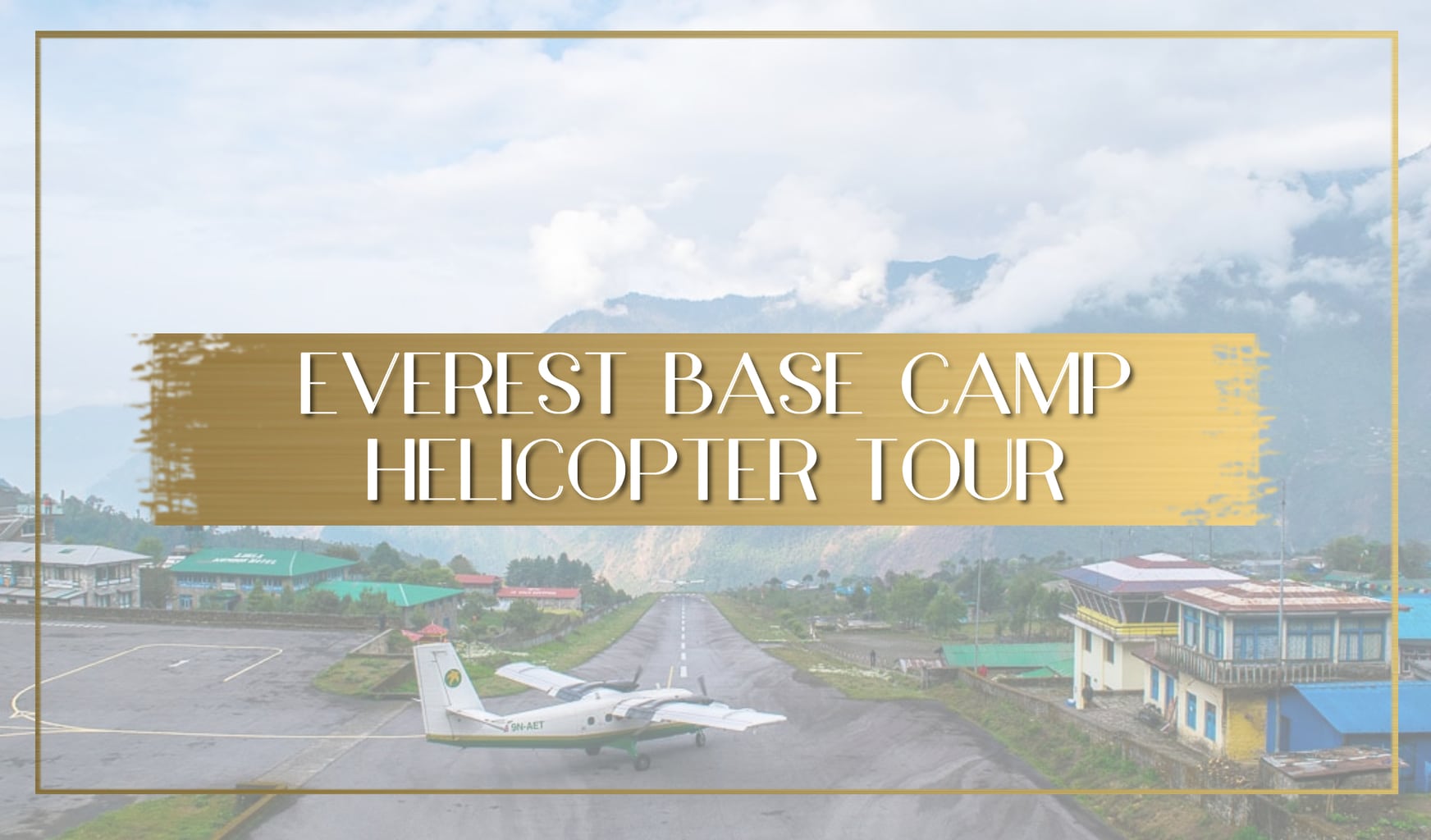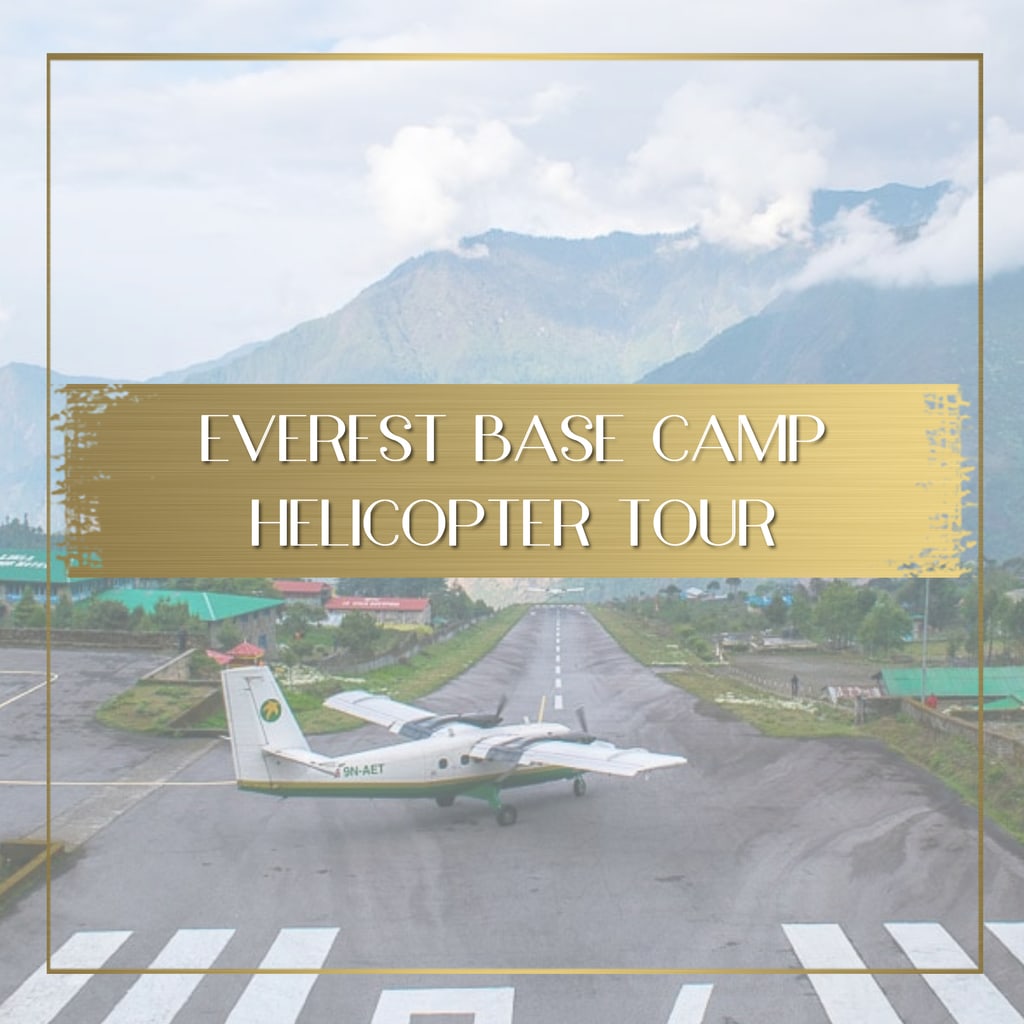
A plane ride over the Himalayas was not enough. We boarded the 30min scenic flight and spend the journey looking through the windows, staring at the snow capped mountains and the bright sun reflecting on the white snow.
The windows were scratched and dirty and we could not truly enjoy the views so we wondered, should we have taken that helicopter trip to Everest Base Camp instead? Wouldn’t it be amazing to see the sunrise over Everest from a helicopter?
There was no going back. This is my helicopter tour to Everest Base Camp experience…
The beginning of the Everest base camp helicopter tour
The day after our scenic plane ride we were back at the domestic airport in Kathmandu, at the crack of dawn, to board our private Everest helicopter tour, where you can see the highest mountain in the world. You can ascend either from Nepal or Tibet, we chose Nepal this time round. Which should you choose? Read here for more info.
Apart from trains, helicopters are my favourite form of transportation. The views from above are just stunning. So a helicopter ride to Everest Base Camp was a no-brainer. After much waiting around we were finally in the helicopter, seat belt tightened, the sun on the horizon blinding us, fog hovering low in the sky. The blades started to turn and off we went, into the paddies and the terraces that surround Kathmandu.
The flight to Lukla
At first, the landscapes were green and brown, in all shades of a rich yet challenging agricultural land. The steep terraces are efficiently used to cultivate all sorts of local vegetables. Reminiscent of the rice terraces elsewhere in Southeast Asia, the journey to Everest Base Camp started with miles and miles of pretty hills.
Then, everything became arid and untouched. Around 45min after we had taken off from Kathmandu, we were still glued to the windows trying to take everything in.
Every time I am on a helicopter I have a feeling of detachment, as if I am not there but instead watching it all on the television. Everything looks miniature and yet as if so close you could extend your arm and touch it.
Around half way through the journey our pilot landed in Lukla. Lukla airport is the starting point of the Everest Base Camp ascend and one of the scariest airports in the world.
The steep mountain wall on one side, the abyss on the other, and an extremely short runaway, landing here is a pilot’s worst nightmare. As if to prove the point, a derelict plane lays on the side of the runaway. The pilot missed the runaway and crashed into the mountain wall. All passengers died on collision. Luckily, from an helicopter the landing is much less daunting.
The stop was required to drop fuel and we did not disembark. When the pilot boarded, he quickly hooked himself to the oxygen bottle. Attitude is the biggest danger of such trips and it is important that the pilot stays safe.
We could see some people getting ready for their Everest Base Camp trek, one of the most popular treks in Nepal, although there are other lesser known but equally stunning ones that visit more remote and arguably undiscovered parts of the country.
Helicopter rides are now commercially available on the Nepalese side! Book your ride today right here!
Lukla to Everest base camp by helicopter
We then quickly climbed to 3,000, 4,000 and finally over 5,000 meters high. On the way from Lukla on the Everest Base Camp helicopter tour you can spot the occasional trekker. The paths did not look particularly steep but rather a snaking flattish pathway, the main reason for failure to complete the trek is altitude sickness from lack of acclimatisation rather than poor fitness levels.
The landscape continued to be arid and ranging from beige to dark brown with white tipped mountains that looked like reef shark‘s tails. There are few inhabited places on the way with the exception of the Everest View Hotel and a couple of other accommodations mainly built for trekkers. A monastery, the highest in the world, on a privileged view point stands as if guarding he mountain.
All climbing permits for the rest of the year had been withdrawn the previous month when an avalanche killed several hikers and porters so Base Camp was extremely quiet and empty shortly after this sad event. The avalanche was clearly visible on the mountain wall. The steep ascend from Base Camp had been covered with a river of snow in an iceberg blue colour only pure ice or water can turn into. The tiny tents were still waiting while on our Base Camp helicopter tour. They were in bright yellow and orange colours and looked like little dots from the sky. Some still kept hope they would be allowed to try the ascend.
Landing on the Everest base camp helicopter tour
We hovered above Base Camp, toured the area at around 5,500 above sea level and landed slightly above the camp on a flat field with frozen soil at over 5,300 meters. When we got out of the helicopter temperatures were drastically lower than down in Kathmandu. In over an hour we went from the over 30 degrees in the valley to zero at Base Camp.
The excitement of the moment numbed us and we felt nothing despite the freezing temperatures and glacial wind. Packing the right clothes also helped. The pilot ushered us out and warned us to come back after only a couple of minutes. He was afraid we could feel sick and collapse. The helicopter did not stop. So we jumped off and rushed to capture the moment with panoramic shots and selfies galore.
Altitude sickness hit us straightaway and we both felt dizzy and slightly dazed after only a couple of minutes.
Back in the helicopter, adrenaline pumping, we were still feeling the remnants of the altitude sickness which slowly subsided as soon as we started to descend. We wished we could have stayed longer.
Everest View Hotel was empty except for a Dutch father and son who were on their way to the Camp. The hotel’s terrace offers uninterrupted, indescribable views of the Himalayas and Everest peak. It is a stunning once in a lifetime view. We dipped toasts in egg yolks while we enjoyed the most majestic mountain in the distance. As the sun rose the sky cleared and became brighter making the view more pristine. The mountain, which has tempted so many climbers and taken the lives of several more seemed so harmless, so welcoming.
We got to enjoy the view longer than usual because our pilot was called to rescue a climber needing urgent evacuation so he left us there while he returned to Base Camp and down to Lukla with the climber. No matter how much acclimatisation altitude sickness can hit the healthiest person and once it does, nothing can heal better than descending. Our pilot confessed that he was responding to such calls on a daily basis, in peak season, more than once a day.
Was this for real?
Back in Kathmandu, we were still touched by such a magical journey and firmly convinced we were incredibly lucky to have experienced this once in a lifetime moment, even if short. Should we ever have the time to trek to Base Camp, I now know it would truly be a once in a lifetime experience.
Update: I had the opportunity to climb at to Everest Base Camp on the Tibetan side after a train ride from Xining to Lhasa. Read my full review here!
This would make a great addition to your #helitravel Pinterest board
